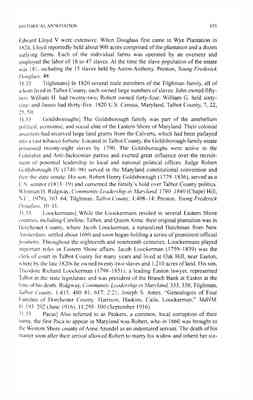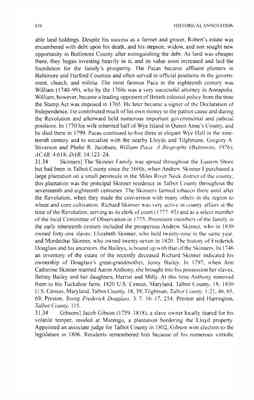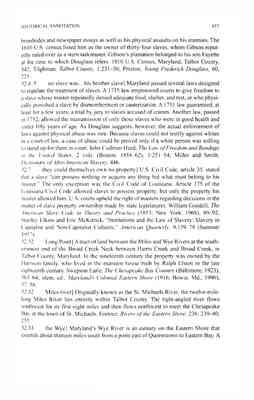Pages
26
654 HISTORICAL ANNOTATION
White Barwick, the new husband of Andrew's widow, Ann. Aaron Anthony Ledger B, 1812-26, folders 95, 159, Dodge Collection, MdAA; Preston, Young Frederick Douglass, 27, 91, 225. 30.1 virago] A manlike female, heroic warrior. 30.5 Her death] Harriet Bailey died on the Holme Hill Farm after a long illness in late 1825 or early 1826. Preston, Young Frederick Douglass, 64. 30.29-30 slavery in...mildest form] According to historian Barbara Jeanne Fields and others, the attitudes of and actions taken by slaveholders in Maryland were similar to those in other southern states, so in terms of provisions and treatment, enslavement in the border state did not differ much from the Lower South. Still, the brisk pace of slave trading and the prevalence of small-scale slaveholding, both of which disrupted the fabric of families, did make practices in Maryland remarkable and, in some ways, more bitter than elsewhere. Barbara Jeanne Fields, Slavery and Freedom on the Middle Ground: Maryland during the Nineteenth Century (New Haven, Conn., 1985), 23-26; Christopher Phillips, Freedom's Port: The African American Community of Baltimore, 1790-1860 (Urbana, Ill., 1997), 14-20; Frank Towers, The Urban South and the Coming of the Civil War (Charlottesville, Va., 2004), 61-62, 173; Steven Deyle, Carry Me Back: The Domestic Slave Trade in American Life (New York, 2005), 86-87, 98-99. 31.6 home plantation of Col. Edward Lloyd, in Talbot County] Wye House. 31.7-9 It was far. . .in its neighborhood] As late as 1833 the community of St. Michaels did not have a public school for the children of local planters and farmers. Preston, Young Frederick Douglass, 110. 31.12 Page] Joel Page (1784-1832) was born in Conway, Franklin County, Massachusetts. In 1805 he graduated from Yale College and sometime soon after that became the resident tutor in the household of Edward Lloyd V. Among his tutees over the years was Edward Lloyd VI. Page became a beloved member of the Lloyd household and remained there until he died in 1832 of complications related to psychological disorder. He was interred in the Lloyd burial grounds. Franklin Bowditch Dickson Dexter, Biographical Sketches of the Graduates of Yale College, 6 vols. (New York, 1911), 5:788; Tilghman, Talbot County, 1:211; Preston, Young Frederick Douglass, 59, 221. 31.17 mechanics] White artisans in the South identified themselves as mechanics in the early nineteenth century. White mechanics distinguished themselves from free black artisans by virtue of their legal rights and moral obligations to their communities as taxpayers and as citizens. Unlike their eighteenth-century predecessors, nineteenthcentury mechanics embraced the principles of market capitalism as a natural precondition of their advancement in the traditional artisan hierarchy through a process of material accumulation. Bruce Laurie, Artisans into Workers: Labor in Nineteenth-Century America (New York, 1989), 49-51; David R. Roediger, The Wages of Whiteness, rev. ed. (New York, 2003 ), 52. 31.25-27 this plantation. . .own vessels] The Maryland property holdings of
27
HISTORICAL ANNOTATION 655
Edward Lloyd V were extensive. When Douglass first came to Wye Plantation in 1824, Lloyd reportedly held about 900 acres comprised of the plantation and a dozen outlying farms. Each of the individual farms was operated by an overseer and employed the labor of 18 to 47 slaves. At the time the slave population of the estate was 181, including the 15 slaves held by Aaron Anthony. Preston, Young Frederick Douglass, 48. 31.33 Tilghmans] In 1820 several male members of the Tilghman family, all of whom lived in Talbot County, each owned large numbers of slaves. John owned fiftytwo; William H. had twenty-two; Robert owned forty-four; William G. held sixtynine; and James had thirty-five. 1820 U.S. Census, Maryland, Talbot County, 7, 22, 25, 50. 31.33 Goldsboroughs] The Goldsborough family was part of the antebellum political, economic, and social elite of the Eastern Shore of Maryland. Their colonial ancestors had received large land grants from the Calverts, which had been parlayed into a vast tobacco fortune. Located in Talbot County, the Goldsborough family estate possessed twenty-eight slaves by 1790. The Goldsboroughs were active in the Federalist and Anti-Jacksonian parties and exerted great influence over the recruitment of potential leadership to local and national political offices. Judge Robert Goldsborough IV (1740-98) served in the Maryland constitutional convention and then the state senate. His son, Robert Henry Goldsborough (1779-1836), served as a U.S. senator (1813-19) and cemented the family's hold over Talbot County politics. Whitman H. Ridgway, Community Leadership in Maryland, 1790-1840 (Chapel Hill, N.C., 1979), 163-64; Tilghman, Talbot County, 1:408-14; Preston, Young Frederick Douglass, 1, 10-11. 31.33 Loockermans] While the Loockermans resided in several Eastern Shore counties, including Caroline, Talbot, and Queen Anne, their original plantation was in Dorchester County, where Jacob Loockerman, a naturalized Dutchman from New Amsterdam, settled about 1680 and soon began holding a series of prominent official positions. Throughout the eighteenth and nineteenth centuries, Loockermans played important roles in Eastern Shore affairs. Jacob Loockerman (1759-1839) was the clerk of court in Talbot County for many years and lived at Oak Hill, near Easton, where by the late 1820s he owned twenty-two slaves and 1,210 acres of land. His son, Theodore Richard Loockerman (1798-1851), a leading Easton lawyer, represented Talbot in the state legislature and was president of the Branch Bank at Easton at the time of his death. Ridgway, Community Leadership in Maryland, 333, 338; Tilghman, Talbot County, 1:415, 480-81, 617; 2:21; Joseph S. Ames, "Genealogies of Four Families of Dorchester County: Harrison, Haskins, Caile, Loockerman." MdHM, 11:193-202 (June 1916), 11:295-300 (September 1916). 31.33 Pacas] Also referred to as Peakers, a common, local corruption of their name, the first Paca to appear in Maryland was Robert, who in 1660 was brought to the Western Shore county of Anne Arundel as an indentured servant. The death of his master soon after their arrival allowed Robert to marry his widow and inherit her sizable
28
656 HISTORICAL ANNOTATION
land holdings. Despite his success as a farmer and grocer, Robert's estate was encumbered with debt upon his death, and his stepson, widow, and son sought new opportunity in Baltimore County after extinguishing the debt. As land was cheaper there, they began investing heavily in it, and its value soon increased and laid the foundation for the family 's prosperity. The Pacas became affluent planters in Baltimore and Harford Counties and often served in official positions in the government, church, and militia. The most famous Paca in the eighteenth century was William (1740-99), who by the 1760s was a very successful attorney in Annapolis. William, however, became a leading opponent of British colonial policy from the time the Stamp Act was imposed in 1765. He later became a signer of the Declaration of Independence. He contributed much of his own money to the patriot cause and during the Revolution and afterward held numerous important governmental and judicial positions. In l 770 his wife inherited half of Wye Island in Queen Anne's County, and he died there in 1799. Pacas continued to live there at elegant Wye Hall in the nineteenth century and to socialize with the nearby Lloyds and Tilghmans. Gregory A. Stiverson and Phebe R. Jacobsen, William Paca: A Biography (Baltimore, 1976); ACAB, 4:618; DAB, 14:123-24. 31.34 Skinners] The Skinner Family was spread throughout the Eastern Shore but had been in Talbot County since the 1660s, when Andrew Skinner I purchased a large plantation on a small peninsula in the Miles River Neck district of the county; this plantation was the principal Skinner residence in Talbot County throughout the seventeenth and eighteenth centuries. The Skinners farmed tobacco there until after the Revolution, when they made the conversion with many others tn the region to wheat and corn cultivation. Richard Skinner was very active in county affairs at the time of the Revolution, serving as its clerk of court (1777-85) and as a select member of the local Committee of Observation in 1775. Prominent members of the family in the early nineteenth century included the prosperous Andrew Skinner, who in 1830 owned forty-one slaves; Elizabeth Skinner, who held twenty-nine in the same year; and Mordechai Skinner, who owned twenty-seven in 1820. The history of Frederick Douglass and his ancestors, the Baileys, is bound up with that of the Skinners. In 1746 an inventory of the estate of the recently deceased Richard Skinner indicated his ownership of Douglass's great-grandmother, Jenny Bailey. In 1797, when Ann Catherine Skinner married Aaron Anthony, she brought into his possession her slaves, Betsey Bailey and her daughters, Harriet and Milly. At this time Anthony removed them to his Tuckahoe farm. 1820 U.S. Census, Maryland, Talbot County, 18; 1830 U.S. Census, Maryland, Talbot County, 18, 39; Tilghman, Talbot County 1:21, 46, 65, 69; Preston, Young Frederick Douglass, 3-7, 16-17, 214; Preston and Harrington, Talbot County, 115. 31.34 Gibsons] Jacob Gibson (1759-1818), a slave owner locally feared for his volatile temper, resided at Marengo, a plantation bordering the Lloyd property. Appointed an associate judge for Talbot County in 1802, Gibson won election to the legislature in 1806. Residents remembered him because of his numerous vitriolic
29
HISTORICAL ANNOTATION 657
broadsides and newspaper essays as well as his physical assaults on his enemies. The 1810 U.S. census listed him as the owner of thirty-four slaves, whom Gibson reputedly ruled over as a stern taskmaster. Gibson's plantation belonged to his son Fayette at the time to which Douglass refers. 1810 U.S. Census, Maryland, Talbot County, 342; Tilghman, Talbot County, 1:231-56; Preston, Young Frederick Douglass, 60, 221. 32.4-5 no slave was. . .his brother slave] Maryland passed several laws designed to regulate the treatment of slaves. A 1715 law empowered courts to give freedom to a slave whose master repeatedly denied adequate food, shelter, and rest, or who physically punished a slave by dismemberment or cauterization. A 1751 law guaranteed, at least for a few years, a trial by jury to slaves accused of crimes. Another law, passed in 1752, allowed the manumission of only those slaves who were in good health and under fifty years of age. As Douglass suggests, however, the actual enforcement of laws against physical abuse was rare. Because slaves could not testify against whites in a court of law, a case of abuse could be proved only if a white person was willing to stand up for them in court. John Codman Hurd, The Law of Freedom and Bondage in the United States, 2 vols. (Boston, 1858-62), 1:251-54; Miller and Smith, Dictionary of Afro-American Slavery, 446. 32.7 they could themselves own no property] U.S. Civil Code, article 35, stated that a slave "can possess nothing or acquire any thing but what must belong to his master." The only exception was the Civil Code of Louisiana. Article 175 of the Louisiana Civil Code allowed slaves to possess property, but only the property his master allowed him. U.S. courts upheld the right of masters regarding decisions in the matter of slave property ownership made by state legislatures. William Goodell, The American Slave Code in Theory and Practice (1853; New York, 1968), 89-92; Stanley Elkins and Eric McKitrick, "Institutions and the Law of Slavery: Slavery in Capitalist and Non-Capitalist Cultures," American Quarterly, 9:159-79 (Summer 1957). 32.32 Long Point] A tract of land between the Miles and Wye Rivers at the southernmost end of the Broad Creek Neck between Harris Creek and Broad Creek, in Talbot County, Maryland. In the nineteenth century the property was owned by the Harrison family, who lived in the mansion house built by Ralph Elston in the late eighteenth century. Swepson Earle, The Chesapeake Bay Country (Baltimore, 1923), 363-64; idem. ed., Maryland's Colonial Eastern Shore (1916; Bowie, Md., 1996), 37-38. 32.32 Miles river] Originally known as the St. Michaels River, the twelve-milelong Miles River lies entirely within Talbot County. The right-angled river flows southwest for its first eight miles and then flows northwest to meet the Chesapeake Bay at the town of St. Michaels. Footner, Rivers of the Eastern Shore, 236, 239-40, 255. 32.33 the Wye] Maryland 's Wye River is an estuary on the Eastern Shore that extends about thirteen miles south from a point east of Queenstown to Eastern Bay. A
30
658 HISTORICAL ANNOTATION
branch, the Wye East River, about fifteen miles long, extends south and southeast from near Wye Mills, along the borders of Talbot and Queen Anne Counties, to the Wye River near its mouth. Footner, Rivers of the Eastern Shore, 294-308; Cohen, Columbia Gazetteer, 3:3497. 32.34 "Swash,"] In the sense used here, swash is a body of water moving forcibly or dashing against an object. 32.36 large sloop, the "Sally Lloyd,"] In 1819 Edward Lloyd V ordered the construction of a new sloop to replace the aging schooner Elizabeth & Ann, which carried his crops to markets in Baltimore and Annapolis and brought back supplies to his scattered Talbot County farms. Thomas Auld had supervised the construction, in Joseph Kemp's St. Michaels shipyard, of the replacement vessel named the Sally Lloyd in honor of the colonel's daughter, Sally Scott Lloyd. Auld remained in Lloyd's employment as the master of the Sally Lloyd, which was manned by a slave crew. The latter gained celebrity status among the Lloyd slaves because of their contact with the world outside the rural plantations and their ability to purchase small items in the cities for resale to other slaves. Various account books and cash books, Land Papers-- Maintenance of Property, Land Volume 39, reel 10, Lloyd Family Papers, MdHi. 32.37 favorite daughter of the Colonel] Sally Scott Lloyd Lowndes, daughter of Edward Lloyd V, was the namesake of her mother, Sally Scott Murray Lloyd. She married Charles Lowndes, a U.S. Navy officer, on 24 May 1824. Colonel Lloyd purchased an estate called the Anchorage on the Miles River as a gift for the couple. Their son, Lloyd Lowndes, served as governor of Maryland from 1896 to 1900. Rossiter Johnson, ed., The Twentieth Century Biographical Dictionary of Notable Americans, 10 vols. (Boston, 1904). 7:67; Tilghman, Talbot County, 1:207; Preston, Young Frederick Douglass, 47, 224. 33.1 Sevier] During the years 1809-12 and possibly thereafter, William Sevier worked for Aaron Anthony, probably as an overseer on his farms. In 1820 he was between twenty-six and forty years old. At that time Sevier occupied a small red frame house on the east side of Wye House's Long Green, and was Edward Lloyd V's overseer for the more than 150 slaves at the main plantation. Aaron Anthony Ledger A, 1790-1818, folders 94, 19, Aaron Anthony Ledger C, 1809 27, folders 96, 1, 3, 13, 87, 119, 124, 177, 286, 291, both in Dodge Collection, MdAA; 1820 U.S. Census, Maryland, Talbot County, 7; Preston, Young Frederick Douglass, 70-71, 222. 33.2 my old master's] Aaron Anthony resided in a two-story brick structure that dated back to the 1660s. Anthony and the Lloyd family had split the cost of remodeling the house in 1808, and it thereafter became popularly known as the "Captain's House." The house had a wooden kitchen, slightly separated from the main dwelling for safety considerations, where Douglass spent much time as a youth. Preston, Young Frederick Douglass, 27-28. 33.15 the great house] Wye House. the principal residence of Edward Lloyd V, located on the plantation of the same name, was built to replace the original house destroyed by British troops during the American Revolution. Still standing, Wye




